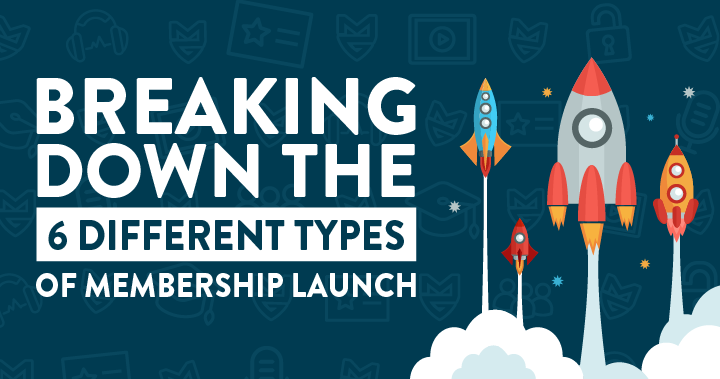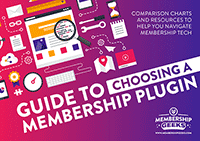When people think about launching a membership, they think about the day that they finally open their doors for the very first time and welcome their first crop of new members.
It's a big deal!
However that grand opening isn't the only opportunity you have to launch…
In fact there are 6 different types of launches that can come into play at various stages of your membership journey.
Here's a full breakdown:
1) The Traditional Launch
The traditional approach is the launch style you’re probably already familiar with.
It's when you open the doors to a brand new membership and take it to market for the very first time.
The conventional way to launch a membership site is to do most (if not all) of the hard work before you release it to your audience.
For a traditional launch, you’ll have all of your technology ready, your content loaded in and your waitlist prepared.
You’ll have spent lots of time and effort building your audience’s suspense and excitement through promotional and marketing activity, and you'll kick things off with a big a launch event, so you can start with a bang and get an influx of initial members.
This first influx is the foundation on which you’ll build your membership business.
You'll be looking to get a lot of eyeballs and a lot of attention on your brand new community, compelling people to join with a no-brainer launch offer.

Your launch strategy in a nutshell…
This is your big shot to hit the ground running and build the momentum that will carry your membership forward.
2) The Enrolment Window Launch
If you follow the closed door membership model, typically your strategy will involve only making your membership available to join at a few designated times of year.
The reopening of your enrolment window is often referred to as a ‘launch' (even though it doesn't involve bringing something new to market)
Usually the window of opportunity to join will be short – a week at most – and once the deadline passes, the doors close again and potential members then need to wait until your next re-opening.
So if you've ever seen someone “launching” the same membership for the fifth or sixth time, this is the type of launch they mean.
It's not a new market product, but another chance to sign-up.
This type of closed-door strategy relies heavily on the scarcity and urgency that comes from having such limited opportunities to join; and they're often promoted similarly to a ‘traditional launch' with launch events and promotional offers to increase sign-ups.
3) The Seed Launch
The seed launch is essentially a ‘pre-sale' of the membership you intend to create.
This is sometimes referred to as a founder launch, pre-sell launch, or a founding member launch.
The idea is that you tell your audience all about this amazing new membership you're about to start creating, and offer them the “opportunity” to pay some money now in order to be first in the door when it becomes a tangible product.
Typically, the cost for them to do so will be much lower than the price you'll eventually charge the public; and more often than not it involves them paying a very low one-time fee in exchange for lifetime access.
Jeff Walker popularized this idea in his book, “Launch”.
The name comes from the idea that this type of offer will not only validate your concept, but will also generate some seed money that you can use to develop the membership program and cover the costs of buying plugins, paying for web hosting and so on.
But you're not releasing a actual product yet.
As such it can be a very hard sell – and sometimes a poor response to a seed launch might dissuade you from going any further with an idea that actually has potential.
Another drawback to this type of launch is there’s a chance that your idea could change drastically in the development stages, or you might even decide not to develop the product at all; and as such may have to give people their money back.
Assuming you haven't already spent it…
4) The MVP Launch
This type of launch involves releasing a minimum viable product (MVP) to your audience so that you can test and validate a tangible membership idea.
It’s more of a middle ground between the traditional launch and a seed launch.
Effectively it's a “pilot program”, where you offer up a stripped back version of what your membership will ultimately become.
No frills, no bells and whistles, a little rougher around the edges with some basic initial content and features.
It’s still cheaper for people to sign up to than a final product launch, but the fact that a ‘slimmed down' version of your product actually exists can compel more people to sign-up than a seed launch.
Our approach to creating an MVP version of your membership is called the “Lean Live Launch” strategy:
Keeping the tech simple (“lean”) and embracing the live content as a way to deliver huge amounts of value for little upfront work makes it possible to create and launch a compelling MVP product much earlier in your membership journey.
5) The Beta Launch
The beta testing launch is a popular way to iron out any kinks in your product before you release it to the public.
Often membership owners will invite a small, select number of users to test their site to help expose any potential issues to get it into the best possible place ahead of its big launch.
This is a great launch type for two reasons:
One, it’s the most universally recognized way of weeding out any technical problems or mistakes in your site.
Secondly, it establishes a community that is already talking about your product.
When choosing beta testers, you could pick people close to you, from your waitlist, or even past customers.
These people will be the first part of your membership community, so when you do launch publicly, new members will join an already existing, active community.
One thing to note about beta testing is that this isn’t a type of launch you typically make money from.
It’s even common for membership owners to reward beta testers with free membership for their help.
Beta testing is all about testing your product and putting it through its paces to make sure it can withstand use from lots of members.
It also helps to prevent issues when it does go live.
6) The Soft Launch
The soft launch is ideal for first-time membership owners who need a little extra breathing room in the early stages.
Maybe they need a little reassurance that they can handle running a membership (or indeed that it's something they enjoy)
Perhaps they have time constraints that need navigating as they find their feet.
Or maybe they want to get started without the pressure of a big launch.
To launch using this method, you open the doors to your membership with very little promotion, and then close enrolment when you reach a set number of members.
You might even limit the people you invite to join to those in your existing networks or on your waitlist.
This is a fantastic way to do a practice run of your membership and refine things so that you're in a better position when you do a full public launch.
Combining launch strategies
Whichever launch strategy you choose for your membership site, remember that they’re not mutually exclusive!
You can do a seed launch and then an MVP launch, or a beta launch before a traditional launch.
Heck, you could even find a way to do all six! (although we probably wouldn't recommend it!)
Hopefully you're now better able to determine which launch strategy is right for your business and feel more confident about bringing your membership site to market.





